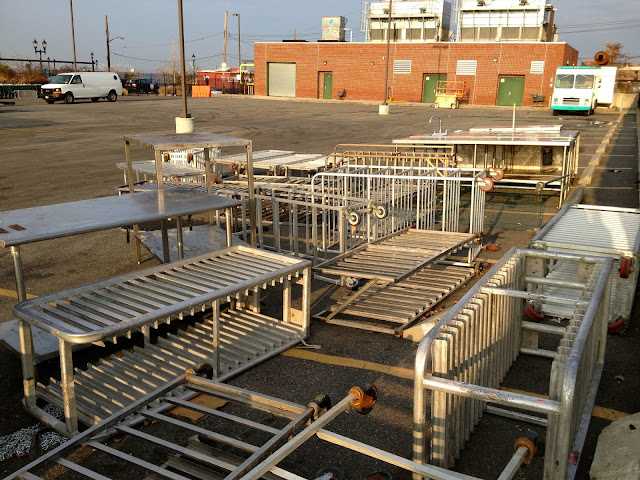 |
| Concrete loading platforms in the atrium of Building B |
At the western edge of Sunset Park stands a massive monument to American military might. The Brooklyn Army Terminal originally comprised 5 million square feet of space. At its peak during World War II, it employed 56,000 personnel who witnessed 3 million troops and 37 million tons of supplies pass through the complex. For a more in-depth look at its life as a military supply depot, visit TrainWeb, which presents a nice summary of the terminal's history, along with a great collection of archival photos.
In 1981, the City of New York purchased the facilities from the U.S. Government. Since then, NYC has restored approximately 60% of the terminal for office and light industrial use. According to the New York Times, The Army Terminal is one of a growing number of former manufacturing structures to be reconstituted for contemporary use, joining the Brooklyn Navy Yard, Industry City and Liberty View Industrial Plaza, among others. As always, you know something has been gestating for some time when the Times picks up on the trend.
The terminal was built in a mere seventeen months, completed in 1919 according to the designs of the famed New York architect Cass Gilbert. This was a bit surprising, as his reputation had been built on the backs of projects such as the Woolworth Building, the famous Neo-Gothic skyscraper. In contrast, the terminal was decidedly modern with its reinforced concrete slabs, its delicate steel truss and glass skylight, its vast and sophisticated system of centrally-controlled elevators, its remarkably un-Gilbertesque lack of ornamentation, and its unquestionably functional design. On the other hand, maybe the kernels of this approach existed underneath the Woolworth's medieval skin, in the bones of the steel-structured skyscraper.
 |
| Exterior Details |
 |
| Arcade connecting Administration Building (right) to Building A (left). View through arcade is to the harbor. |
 |
| View of glass skylight over atrium in Building B |
 |
| Views of Building B's atrium |
Three bridges span the atrium at the third floor, reemerging at the west facade to connect Building B to Building A. A track map posted on TrainWeb clearly illustrates the system of sky bridges, which at one time also extended to connect Building A to the now-defunct warehouses on the piers.
 |
| View of atrium in Building B, with bridge crossing at the 3rd Floor. |
While the complex has been lovingly scrubbed of nearly a century of grime and decay, thankfully it still proudly displays its scars.
 |
| Detail of typical concrete loading platform. Note the diagonal steel reinforcement added for structural remediation. |
 |
| Concrete pier at Building B ground floor loading platform |






























